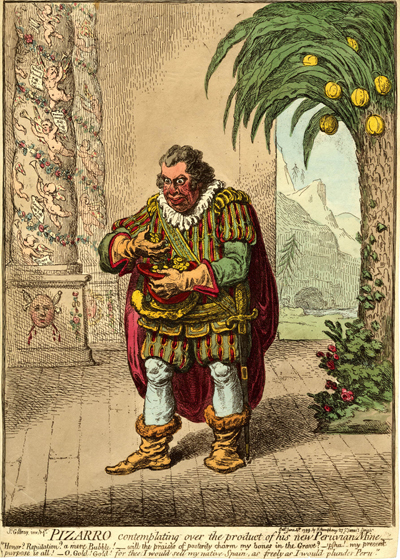Pizarro Contemplating. . .
Pizarro Contemplating Over the Product of his New Peruvian Mine was prompted by the considerable (and to Gillray, undeserved) financial success of Richard Brinsley Sheridan's new play Pizarro which had opened on May 24th at Sheridan's own Theatre Royal in Drury Lane. It was the first substantial play from Sheridan since The Critic in 1779, and was consequently highly anticipated. Like The Critic, Pizarro was loosely based on another play—in this case The Spaniards in Peru by the prolific German playwright August von Kotzebue, who was very much the rage at the time.* The combination of Kotzebue and Sheridan was box office magic. According to the May 25th London Star:
Never was there so much curiosity, so ardent a desire to see a Play. The doors were besieged at three o'clock, and when they opened, the crowding and confusion were dreadful. Crowds at the pit and gallery doors are common, but the crowd at the box door last night, was equal to any that ever happened at them. The whole boxes were taken, and yet thousands went who had no places.
Although contrived and declamatory to most modern sensibilities, the play with its seeming patriotism and the call to resist foreign invaders struck exactly the right chord for Englishmen of 1799, as Sheridan no doubt intended it should. Indeed, according to Julie Carlson, Pizarro was the "most popular play of the 1790s in London and the second most popular play of the entire 18th century."

© Trustees of the British Museum
The print shows Sheridan as Pizarro, the villain of the play, gazing greedily at a helmet full of gold. The words he speaks are roughly consistent with the character of Pizarro, but they do not appear in the play itself.
Honor? Reputation? a mere Bubble! - will the praises of posterity charm my bones in the Grave? - 'psha! - my present purpose is all! - O, Gold! Gold! for thee, I would sell my native Spain, as freely as I would plunder Peru.
They are, in fact, much more consistent with Gillray's view of Sheridan as a consummate opportunist, willing to sell out his friends and motivated not so much by princple but by monetary gain. In Bandelures (1791), for instance, Sheridan was shown attempting to seduce Mrs. Fitzherbert literally right behind the Prince's back. In The Dagger Scene (1792) Sheridan's principal lament at being " discovered" is that he has to say "farewell to all our hopes of paying off my debts by a general Bankruptcy! - farewell to all hopes of plunder!" And in his 1798 essay in physiognomy, Doublures of Character, Gillray found the perfect double of Sheridan in Judas Iscariot, who in Matthew 27:3 betrayed Christ for thirty pieces of silver.
Behind Sheridan/Pizarro are two columns of putti representing the major newspapers whose "puffs" of Pizarro helped to ensure its success. Early in his career, Sheridan wrote pseudonymous letters to the editors of major newspapers, praising his play, The Rivals, and he may have followed the similar practice with Pizarro.
The British Museum commentary implies that the face on the foundation of the columns is a tragic mask. But it does not look like any tragic mask that I've ever seen. I think it more likely that the face is that of Warren Hastings, whose trial for corruption in India inspired Sheridan's most famous speeches in Parliament and much of the rhetoric in Pizarro.
* Kotzebue is perhaps best known today as the author of the scandalous play, Lover's Vows, which was to be performed at the newly-constructed home theatre in Jane Austen's Mansfield Park.
Sources and Reading
- Commentary from the British Museum on Pizarro Contemplating. . .
- "Richard Brinsley Sheridan," Wikipedia
- "August von Kotzebue," Wikipedia
- "Theatre Royal, Drury Lane," Wikipedia
- Pizarro, A Tragedy in Five Acts
- Fintan O'Toole, A Traitor's Kiss 1997, pp. 341-355.
- Julie A. Carlson, "Trying Sheridan's Pizarro" Texas Studies of Literature and Language, 1996
- Thomas Wright and R.H. Evans, Historical and Descriptive Account of the Caricatures of James Gillray #244
Comments & Corrections
NOTE: Comments and/or corrections are always appreciated. To make that easier, I have included a form below that you can use. I promise never to share any of the info provided without your express permission.